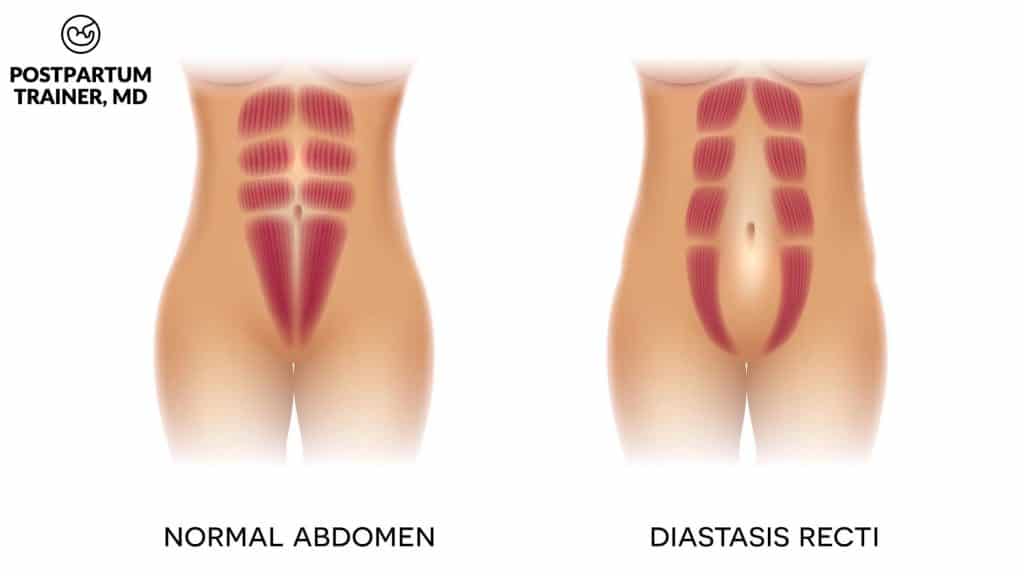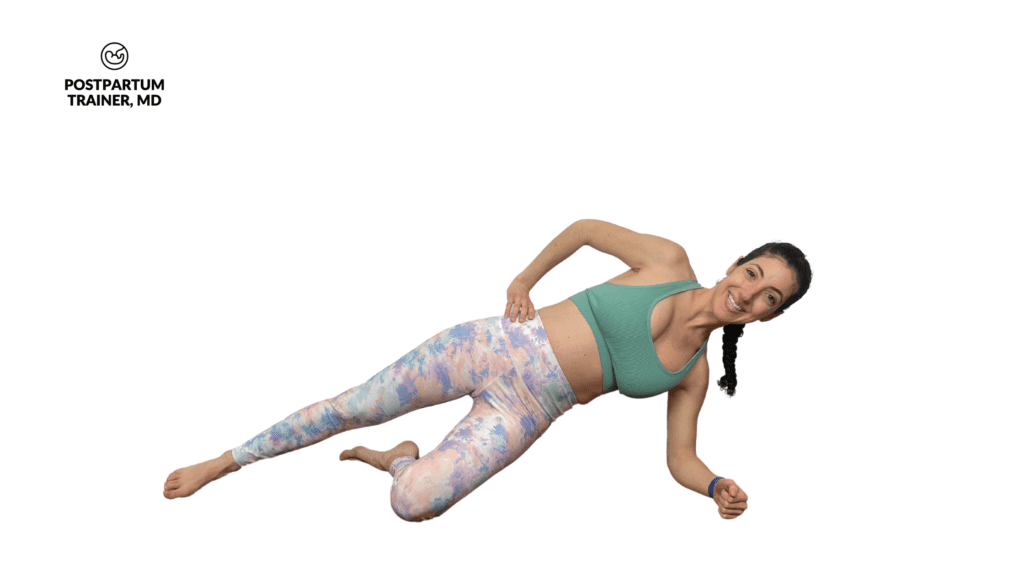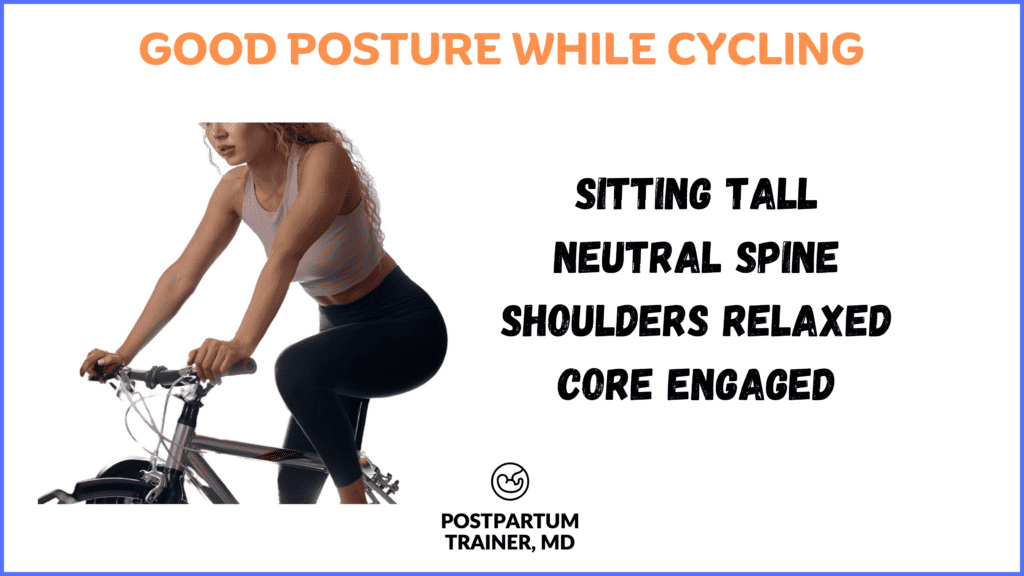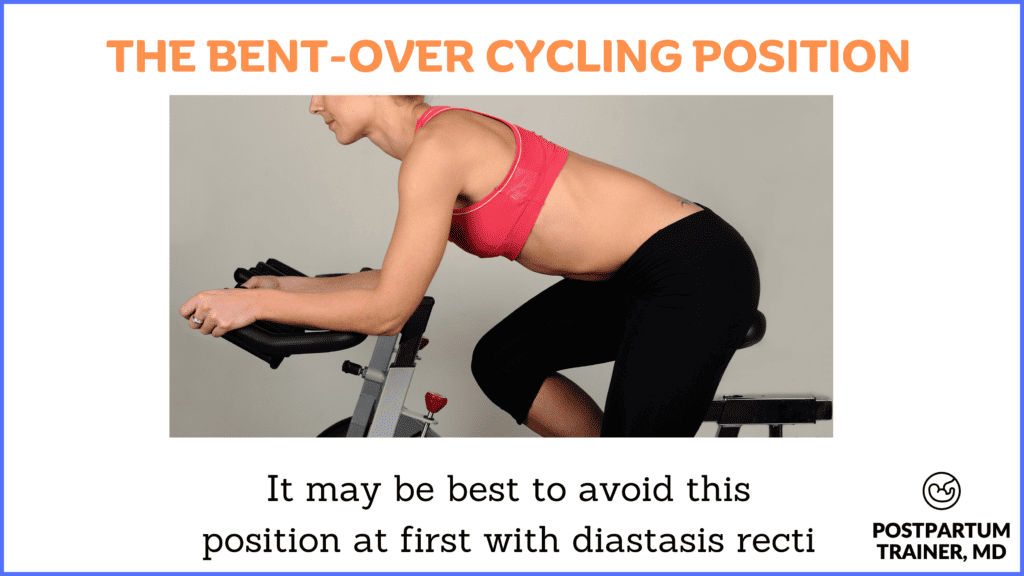Do you have diastasis recti and want to return to your bike?
Well, I have good news for you.
Cycling can be a great exercise option for new moms, even those with diastasis recti.
With that said, it’s crucial to approach it with caution.
Any sudden strain or pressure in your abdomen can cause further damage.
Keep reading to learn about the proper steps before cycling with diastasis recti.
What is Diastasis Recti, and Is It Safe To Cycle With It?
Diastasis recti occurs when the abdominal muscles separate in the midline. This separation leaves a gap between the two rectus abdominis muscles.
The condition is very common during and after pregnancy.
Many cases improve on their own, but you need to avoid further strain on the area before letting it heal.

The good news is that cycling is safe with diastasis recti as long as you take some precautions.
Benefits of Cycling with Diastasis Recti
Cycling offers three main benefits for new moms with diastasis recti:
Low-Impact Cardio
Cycling increases your heart rate without the high-impact stress of other cardio exercises. It’s one of the safest ways to improve cardiovascular fitness postpartum.
Leg and Glute Strengthening
Cycling tones and strengthens the leg and glute muscles. Having strong lower body muscles helps maintain
- An active metabolism
- Good blood flow and
- A healthy body weight.
Mental Health Boost
Outdoor cycling can help clear your mind, reduce stress, and boost energy levels. The sunshine and fresh air provide mental health benefits.
All these perks can aid postpartum recovery for moms with diastasis recti.
When Can You Start?
Consult your doctor before starting any new exercise program postpartum. You should only cycle if your doctor or healthcare provider has cleared you for exercise.
Most women should be able to start around the six-week mark.
If you had a c-section, you may need to wait longer (at least eight weeks).
The timeline varies for every new mom. The most important thing is not rushing into intense exercise before you are ready.
What Can You Do To Prepare?
Knowing how to stabilize your core is essential before hopping on the bike for your first ride.
Start by doing gentle exercises to strengthen your abdominal muscles. Focus your core workouts on abdominal exercises designed for diastasis recti.
Here is an example, the modified side plank.

These types of exercises will teach you the basics of core engagement for when you get back in the saddle.
Improving pelvic floor health by doing kegel exercises is also a good idea.
Taking a few weeks to rebuild your core strength can help you avoid worsening symptoms.
Besides, it will give you greater stability and teach you how to ride with better posture.
How To Start Cycling with Diastasis Recti
When you are ready to start cycling, here are a few tips to get you started.
Take Short Rides
Start slow, especially if you are a beginner. Try cycling for 5-10 minutes at first and increase from there. Going slow gives your body time to adapt.
Use light resistance on these short rides and focus on engaging your core muscles.
Do not push yourself too hard. If you feel any pain in the abdominal area, ease up or take a break.
Focus On Posture
When starting, maintain an upright posture on the bicycle. Sit tall with your shoulders back and relaxed.
Do not hunch or round your shoulders, as this puts more pressure on the abdomen.
Poor posture can also put pressure on your spine and lead to low back pain.

Use Proper Resistance and Speed
Avoid high resistance and climbing steep hills. The increased effort can strain the abdominal muscles and cause injury.
Stick to flat terrain until you get stronger.
Please refrain from rapid sprints or fast intervals.
Build up to higher intensities over time.
Consider A Recumbent Bike
Consider switching to a recumbent bicycle if upright cycling causes you any discomfort.
The reclined position transfers the pressure away from your abdomen. As such, it may be more comfortable in the early stages of cycling.
Other Precautions You Need To Take
Now let’s look at a few other precautions you need to take when cycling with diastasis recti.
Adjusting The Bike Seat (Aka Saddle) & Handlebars
First, you must ensure that you set your bike saddle and handlebars to the correct height.
Since you will be cycling with a tall posture, your handlebar may need to be higher than usual.
When sitting, make sure to align your head, neck, arms, trunk, and pelvis. This posture will help reduce the strain on your abdominal muscles.
Also, adjust the saddle height to protect your hips and knees.
Your knees should have a slight bend when your feet are at the lowest point of the pedal. Also, your hips should not rock from side to side as you pedal.
Breathing Techniques
Next, ensure you are using proper breathing techniques.
Each time you inhale, fill your lungs and avoid shrugging your shoulders. Then exhale in a controlled manner while engaging your core muscles.
This type of breathing will help to protect your abs and engage your pelvic muscles.
Avoid Over-Gripping The Handlebars
Over-gripping can cause tension in your upper body and pull focus away from a stable core.
Do your best to maintain a relaxed position on your shoulders, neck, and arms.

When To Stop
Listen to feedback from your body while cycling with diastasis recti. Stop cycling right away and consult your doctor if you experience the following:
- Worsening abdominal separation: If you see bulging or doming of your abdomen, stop. This symptom may signal that the core muscles are too strained.
- Pain: Pain is a critical warning sign to stop exercising. Look out for hip pain, pelvic pain, low back pain, or abdominal pain.
- Heaviness or pressure in the pelvis: These may be symptoms of pelvic organ prolapse.
- Leakage of urine: Incontinence is a common sign of pelvic floor dysfunction.
- Feelings of lightheadedness or dizziness: Your body may need more recovery time.
- Severe fatigue: You may be overexerting yourself.
Trust your instincts – you know your body best.
Consult with your OB-GYN or pelvic floor physical therapist if you have any of these symptoms. Please take it as a sign to slow down and allow more healing before restarting cycling.
How To Progress In Your Routine
Once you’ve built an initial base of endurance, you can begin to add intensity and duration.
Aim to increase the length of your rides by 5 to 10 minutes each week until you reach 30-45 minutes.
You can also add gentle hills or increase the resistance once your core gets stronger.
After four weeks, try riding outdoors on paved trails if you feel comfortable. Outdoor riding works out more muscle groups than stationary bikes.
Once that feels good, feel free to mix up your cycling. You can add intervals, change terrain, or incorporate strength training.
Other Related Questions
Does cycling tighten the pelvic floor?
Cycling does not directly strengthen the pelvic floor muscles. But, it can provide some indirect benefits.
Cycling is a low-impact exercise that does not put excessive strain on the pelvic floor. Plus, it can help strengthen the surrounding muscle groups in the lower body. Doing so may help re-establish a mind-body connection in the pelvic floor.
Still, pelvic floor exercises (kegels) are necessary to restore pelvic health after childbirth.
Does cycling reduce the postpartum belly?
Cycling by itself does not reduce your postpartum belly. But cycling is an effective cardio exercise that burns calories.
Being in a calorie deficit is necessary for fat loss and reducing belly size.
Cycling alone may not create enough of a deficit, though.
Adjusting your diet is also key.
How do I fix diastasis recti?
Diastasis recti occurs when the connective tissues between the ab muscles are weak and stretched apart.
The primary connective tissue is the linea alba, which runs from the sternum to the pubic bone.
It is important to avoid exercises that put too much pressure on the abdominal wall. These include sit-ups, crunches, and planks. These ab exercises create too much intra-abdominal pressure and can worsen your symptoms.
Instead of traditional ab exercises, opt for low impact exercises that strengthen the deep core muscles.
These muscles include:
- the transverse abdominis,
- the obliques (which sit on the sides of the rectus abdominis)
- and the rectus abdominis (the six-pack)
Here is a list of safe abdominal exercises for DR.
You can also work with a physical therapist to address any pelvic floor dysfunction.
Final Words
Cycling can be a rewarding part of a new mom’s fitness routine with diastasis recti.
The low-impact nature of cycling keeps stress on the abdominal muscles low.
Be sure to take your time and get the green light from your provider. (Usually, six weeks postpartum is a safe place to start).
Start with a conservative approach and trust the healing process!
Here is a list of other cardio workout routines you can do with diastasis recti!
Related Posts:
Get Four Free Workouts To Help Strengthen Your Pelvic Floor & Heal Your Mommy Tummy!

Brittany Robles, MD, MPH, CPT
Brittany Robles is a full-time OBGYN physician, a NASM certified trainer, and a prenatal and postnatal fitness specialist. She holds a Master of Public Health degree in maternal health with a special interest in exercise and nutrition. She is also the co-author of The White Coat Trainer. Learn more about her here.
Sharing is Caring – Send This To A Mom In Need!
